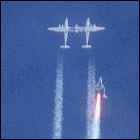 Virgin Galactica’s suborbital tourist spacecraft SpaceShip Two is launched on its first rocket-powered test since January 2014, this time using a modified rocket engine and a fuel mixture different from its previous test flights. Within seconds of its release and the firing of its engine, things go disastrously wrong: an explosion rips through the vehicle, which tumbles into the Mojave Desert from an altitude of 50,000 feet. One of SpaceShip Two’s pilots, Michael Alsbury, is killed on impact; the other pilot ejects from the vehicle and parachutes to the ground, though he is still severely injured. Virgin Galactic and the National Transportation Safety Board begin an investigation into the accident; though this first flightworthy SpaceShip Two model, the VSS Enterprise, is destroyed, another is under construction.
Virgin Galactica’s suborbital tourist spacecraft SpaceShip Two is launched on its first rocket-powered test since January 2014, this time using a modified rocket engine and a fuel mixture different from its previous test flights. Within seconds of its release and the firing of its engine, things go disastrously wrong: an explosion rips through the vehicle, which tumbles into the Mojave Desert from an altitude of 50,000 feet. One of SpaceShip Two’s pilots, Michael Alsbury, is killed on impact; the other pilot ejects from the vehicle and parachutes to the ground, though he is still severely injured. Virgin Galactic and the National Transportation Safety Board begin an investigation into the accident; though this first flightworthy SpaceShip Two model, the VSS Enterprise, is destroyed, another is under construction.
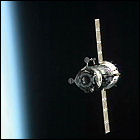 Part of the 33rd full-time crew of the International Space Station lifts off from Russia’s Baikonur Cosmodrome aboard Soyuz TMA-06M. Oleg Novitskiy, Evgeny Tarelkin and Kevin Ford take up residence on the ISS for 143 days, becoming part of the Expedition 33/34 crews. All three return to Earth in March 2013 aboard the same vehicle.
Part of the 33rd full-time crew of the International Space Station lifts off from Russia’s Baikonur Cosmodrome aboard Soyuz TMA-06M. Oleg Novitskiy, Evgeny Tarelkin and Kevin Ford take up residence on the ISS for 143 days, becoming part of the Expedition 33/34 crews. All three return to Earth in March 2013 aboard the same vehicle.
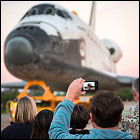 Stripped of critical working systems and engines after her final landing, Space Shuttle Atlantis is moved via a ground transport to a new shuttle museum exhibit at the Kennedy Space Center Visitors’ Center at Cape Canaveral. Having flown 33 times, Atlantis was the last shuttle to travel in space, having returned from orbit the final time in July 2011. Originally intended to be the last addition to the shuttle fleet, construction on Atlantis began in 1980, and was completed in time for Atlantis’ maiden voyage in 1985.
Stripped of critical working systems and engines after her final landing, Space Shuttle Atlantis is moved via a ground transport to a new shuttle museum exhibit at the Kennedy Space Center Visitors’ Center at Cape Canaveral. Having flown 33 times, Atlantis was the last shuttle to travel in space, having returned from orbit the final time in July 2011. Originally intended to be the last addition to the shuttle fleet, construction on Atlantis began in 1980, and was completed in time for Atlantis’ maiden voyage in 1985.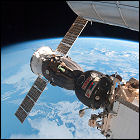 Part of the 34th full-time crew of the International Space Station lifts off from Russia’s Baikonur Cosmodrome aboard Soyuz TMA-07M. Roman Romanenko, Chris Hadfield and Thomas Marshburn take up residence on the ISS for 145 days, becoming part of the Expedition 34/35 crews. All three return to Earth in May 2013 aboard the same vehicle, with Hadfield becoming an internet sensation at the end of the mission with a cover of David Bowie’s “A Space Oddity” recorded aboard the station.
Part of the 34th full-time crew of the International Space Station lifts off from Russia’s Baikonur Cosmodrome aboard Soyuz TMA-07M. Roman Romanenko, Chris Hadfield and Thomas Marshburn take up residence on the ISS for 145 days, becoming part of the Expedition 34/35 crews. All three return to Earth in May 2013 aboard the same vehicle, with Hadfield becoming an internet sensation at the end of the mission with a cover of David Bowie’s “A Space Oddity” recorded aboard the station. The recently formed Golden Spike company, focusing on commercial space exploration and exploitation, announces a contract with aerospace company Northrup Grumman – whose engineers designed and built NASA’s Apollo lunar landers in the 1960s – to do a design study for a new generation of lunar landing hardware. The contract only covers a design, which will need to be finalized so companies hoping to build the lander can bid on the actual construction contract.
The recently formed Golden Spike company, focusing on commercial space exploration and exploitation, announces a contract with aerospace company Northrup Grumman – whose engineers designed and built NASA’s Apollo lunar landers in the 1960s – to do a design study for a new generation of lunar landing hardware. The contract only covers a design, which will need to be finalized so companies hoping to build the lander can bid on the actual construction contract.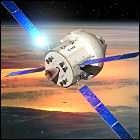 The European Space Agency and NASA sign an agreement allowing ESA to provide service modules for the upcoming Orion manned spacecraft, with the first module flying as part of an unmanned test scheduled to take place in 2017. While the Orion command module capsules will be built for NASA by contractor Lockheed Martin, the service modules to which the capsules will be connected are to be provided by ESA and customized for each mission (which could include long-duration flights to the moon, asteroids, or Mars). The service module’s “X-wing solar panel” design is derived from ESA’s Automated Transfer Vehicle cargo ferries dispatched to the International Space Station; ESA’s commitment to Orion will replace its obligation to provide further unmanned freighters to the space station.
The European Space Agency and NASA sign an agreement allowing ESA to provide service modules for the upcoming Orion manned spacecraft, with the first module flying as part of an unmanned test scheduled to take place in 2017. While the Orion command module capsules will be built for NASA by contractor Lockheed Martin, the service modules to which the capsules will be connected are to be provided by ESA and customized for each mission (which could include long-duration flights to the moon, asteroids, or Mars). The service module’s “X-wing solar panel” design is derived from ESA’s Automated Transfer Vehicle cargo ferries dispatched to the International Space Station; ESA’s commitment to Orion will replace its obligation to provide further unmanned freighters to the space station.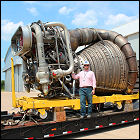 NASA recalls an actual 1960s F-1 engine – of which clusters of five once launched the mighty Saturn V rockets during the Apollo lunar program – from the Smithsonian for refurbishment and, for the first time in over four decades, re-firing on a test stand at Marshall Space Flight Center in Alabama. NASA engineers examine the properties of the F-1 engine – whose performance still outrates the engines used during the Space Shuttle program – to learn how to improve the J-2X engines planned for use in the first stage of the SLS (Space Launch System) booster that will launch Orion vehicles.
NASA recalls an actual 1960s F-1 engine – of which clusters of five once launched the mighty Saturn V rockets during the Apollo lunar program – from the Smithsonian for refurbishment and, for the first time in over four decades, re-firing on a test stand at Marshall Space Flight Center in Alabama. NASA engineers examine the properties of the F-1 engine – whose performance still outrates the engines used during the Space Shuttle program – to learn how to improve the J-2X engines planned for use in the first stage of the SLS (Space Launch System) booster that will launch Orion vehicles. Canadian-born International Space Station Commander Chris Hadfield, following up on a brief communication via Twitter that caught the attention of Star Trek fans and space exploration afficionados alike, conducts a live video chat from orbit with Star Trek star William Shatner (speaking from Earth). The two discuss the risks of space exploration and the technological leaps forward (including means of communication that were strictly science fiction in Star Trek’s heyday), though Shatner can’t convince Hadfield to confirm rumors that the astronaut has volunteered to head up a mission to Mars.
Canadian-born International Space Station Commander Chris Hadfield, following up on a brief communication via Twitter that caught the attention of Star Trek fans and space exploration afficionados alike, conducts a live video chat from orbit with Star Trek star William Shatner (speaking from Earth). The two discuss the risks of space exploration and the technological leaps forward (including means of communication that were strictly science fiction in Star Trek’s heyday), though Shatner can’t convince Hadfield to confirm rumors that the astronaut has volunteered to head up a mission to Mars.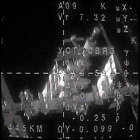 Soyuz TMA-08M lifts off from Russia, testing a new “fast track” trajectory to the International Space Station. With cosmonauts Pavel Vinogradov and Alexander Misurkin, and astronaut Chris Cassidy aboard, the Soyuz capsule reaches the Station only six hours after liftoff, as opposed to the usual two days. The three new crew members join Expedition 35.
Soyuz TMA-08M lifts off from Russia, testing a new “fast track” trajectory to the International Space Station. With cosmonauts Pavel Vinogradov and Alexander Misurkin, and astronaut Chris Cassidy aboard, the Soyuz capsule reaches the Station only six hours after liftoff, as opposed to the usual two days. The three new crew members join Expedition 35.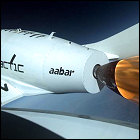 Space passenger line Virgin Galactic tests the Burt Rutan-designed suborbital SpaceShipTwo spacecraft VSS Enterprise at an altitude of over ten miles, reaching a speed of over Mach 1. Virgin’s official report is that the test flight was a complete success; no date is set for a suborbital test flight yet. Virgin is expected to build four more vehicles of the SpaceShipTwo class before moving on to a more advanced design, SpaceShipThree.
Space passenger line Virgin Galactic tests the Burt Rutan-designed suborbital SpaceShipTwo spacecraft VSS Enterprise at an altitude of over ten miles, reaching a speed of over Mach 1. Virgin’s official report is that the test flight was a complete success; no date is set for a suborbital test flight yet. Virgin is expected to build four more vehicles of the SpaceShipTwo class before moving on to a more advanced design, SpaceShipThree.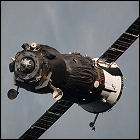 Part of the 36th full-time crew of the International Space Station lifts off from Russia’s Baikonur Cosmodrome aboard Soyuz TMA-09M. Fyodor Yurchikhin, Karen Nyberg and Luca Parmitano take up residence on the ISS for 166 days, becoming part of the Expedition 36/37 crews. Once again, a new “fast track” trajectory propels Soyuz from launch to docking at the ISS in under six hours. This crew returns to Earth in November 2013 aboard the same vehicle.
Part of the 36th full-time crew of the International Space Station lifts off from Russia’s Baikonur Cosmodrome aboard Soyuz TMA-09M. Fyodor Yurchikhin, Karen Nyberg and Luca Parmitano take up residence on the ISS for 166 days, becoming part of the Expedition 36/37 crews. Once again, a new “fast track” trajectory propels Soyuz from launch to docking at the ISS in under six hours. This crew returns to Earth in November 2013 aboard the same vehicle.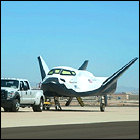 A full-sized structural test article of Sierra Nevada Corporation’s Dream Chaser spacecraft begins “tow tests” at NASA’s Dryden Flight Research Center, verifying the vehicle’s handling on landing gear after touching down. Drop tests and glide tests are scheduled for later in 2013, though all such tests will be completely automated. Sierra Nevada Corporation also provides the main engines for Virgin Galactica’s
A full-sized structural test article of Sierra Nevada Corporation’s Dream Chaser spacecraft begins “tow tests” at NASA’s Dryden Flight Research Center, verifying the vehicle’s handling on landing gear after touching down. Drop tests and glide tests are scheduled for later in 2013, though all such tests will be completely automated. Sierra Nevada Corporation also provides the main engines for Virgin Galactica’s  The Chinese manned space mission Shenzhou 10 lifts off, carrying taikonauts Nie Haisheng, Zhang Xiaoguang and Wang Yaping to the orbiting Tiangong-1 space laboratory module for a stay of over two weeks. This is the fifth manned flight in the history of the Chinese space program, and the second (and is expected to be the last) to visit Tiangong-1. A larger orbital station, Tiangong-2, is under development.
The Chinese manned space mission Shenzhou 10 lifts off, carrying taikonauts Nie Haisheng, Zhang Xiaoguang and Wang Yaping to the orbiting Tiangong-1 space laboratory module for a stay of over two weeks. This is the fifth manned flight in the history of the Chinese space program, and the second (and is expected to be the last) to visit Tiangong-1. A larger orbital station, Tiangong-2, is under development.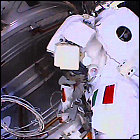 A two-man spacewalk outside the International Space Station is called off when water begins collecting inside the helmet of astronaut Luca Parmitano’s spacesuit. Originally scheduled as a six-and-a-half-hour maintenance spacewalk, the EVA is called off at one hour and the astronauts make a hasty return to the airlock. Once inside, an estimated half liter of water is found inside Parmitano’s space helmet; the remainder of the tasks scheduled for this spacewalk are rescheduled for a later EVA.
A two-man spacewalk outside the International Space Station is called off when water begins collecting inside the helmet of astronaut Luca Parmitano’s spacesuit. Originally scheduled as a six-and-a-half-hour maintenance spacewalk, the EVA is called off at one hour and the astronauts make a hasty return to the airlock. Once inside, an estimated half liter of water is found inside Parmitano’s space helmet; the remainder of the tasks scheduled for this spacewalk are rescheduled for a later EVA.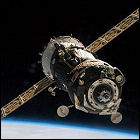 Part of the 37th full-time crew of the International Space Station lifts off from Russia’s Baikonur Cosmodrome aboard Soyuz TMA-10M. Oleg Kotov, Sergey Ryazansky and Michael Hopkins take up residence on the ISS for 166 days, becoming part of the Expedition 37/38 crews. Use of the recently developed “fast track” trajectory resumes, taking Soyuz from launch to docking at the ISS in under six hours. This crew returns to Earth in March 2014 aboard the same vehicle.
Part of the 37th full-time crew of the International Space Station lifts off from Russia’s Baikonur Cosmodrome aboard Soyuz TMA-10M. Oleg Kotov, Sergey Ryazansky and Michael Hopkins take up residence on the ISS for 166 days, becoming part of the Expedition 37/38 crews. Use of the recently developed “fast track” trajectory resumes, taking Soyuz from launch to docking at the ISS in under six hours. This crew returns to Earth in March 2014 aboard the same vehicle.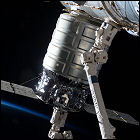 Orbital Sciences’ unmanned Cygnus cargo spacecraft is grappled and docked to the International Space Station via remote manipulator arm. This demonstration model of the Cygnus cargo ship had been launched ten days earlier via Orbital Sciences’ Antares booster from Wallops Island, Virginia. With 1,300 pounds of crew supplies, experiments and other cargo aboard, the Cygnus vehicle is expected to remain attached to the station for a full month before being jettisoned to burn up in Earth’s atmosphere.
Orbital Sciences’ unmanned Cygnus cargo spacecraft is grappled and docked to the International Space Station via remote manipulator arm. This demonstration model of the Cygnus cargo ship had been launched ten days earlier via Orbital Sciences’ Antares booster from Wallops Island, Virginia. With 1,300 pounds of crew supplies, experiments and other cargo aboard, the Cygnus vehicle is expected to remain attached to the station for a full month before being jettisoned to burn up in Earth’s atmosphere.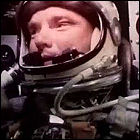 Scott Carpenter, Mercury astronaut and the
Scott Carpenter, Mercury astronaut and the 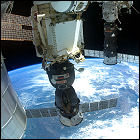 Soyuz TMA-11M is launched from Russia, on a fast-track trajectory to the International Space Station. The crew – Mikhail Tyurin, Rick Mastracchio and Koichi Wakata – arrives just six hours after liftoff. Each of the crew has been in space on at least three prior missions. Also aboard the Soyuz is the Olympic torch, on its own first visit to space; the torch, along with the Expedition 37 crew, returns to Earth in May 2014. Though Soyuz vehicles are usually handed off to the next returning crew, Soyuz TMA-11M returns to Earth with the same crew after a six-month stay. This mission marked the first time the International Space Station was crewed by nine people simultaneously since the end of the Space Shuttle era.
Soyuz TMA-11M is launched from Russia, on a fast-track trajectory to the International Space Station. The crew – Mikhail Tyurin, Rick Mastracchio and Koichi Wakata – arrives just six hours after liftoff. Each of the crew has been in space on at least three prior missions. Also aboard the Soyuz is the Olympic torch, on its own first visit to space; the torch, along with the Expedition 37 crew, returns to Earth in May 2014. Though Soyuz vehicles are usually handed off to the next returning crew, Soyuz TMA-11M returns to Earth with the same crew after a six-month stay. This mission marked the first time the International Space Station was crewed by nine people simultaneously since the end of the Space Shuttle era. The University of Nebraska Press publishes
The University of Nebraska Press publishes  Having successfully demonstrated a working model of the Cygnus unmanned cargo spacecraft in 2013, Orbital Sciences delivers its first Cygnus vehicle under a new commercial resupply contract with NASA. The S.S. C. Gordon Fullerton (named for one of the earliest Shuttle astronauts, now deceased) cargo ship lifts off from Wallops Island, carrying nearly 2,800 pounds of supplies and equipment to the International Space Station. It will remain docked at the ISS for 36 days.
Having successfully demonstrated a working model of the Cygnus unmanned cargo spacecraft in 2013, Orbital Sciences delivers its first Cygnus vehicle under a new commercial resupply contract with NASA. The S.S. C. Gordon Fullerton (named for one of the earliest Shuttle astronauts, now deceased) cargo ship lifts off from Wallops Island, carrying nearly 2,800 pounds of supplies and equipment to the International Space Station. It will remain docked at the ISS for 36 days. Part of the 39th full-time crew of the International Space Station lifts off from Russia’s Baikonur Cosmodrome aboard Soyuz TMA-12M. Aleksandr Skvortsov, Oleg Artemyev and Steven Swanson take up residence on the ISS for 169 days, becoming part of the Expedition 39 and 40 crews. This crew returns to Earth in September 2014 aboard the same vehicle.
Part of the 39th full-time crew of the International Space Station lifts off from Russia’s Baikonur Cosmodrome aboard Soyuz TMA-12M. Aleksandr Skvortsov, Oleg Artemyev and Steven Swanson take up residence on the ISS for 169 days, becoming part of the Expedition 39 and 40 crews. This crew returns to Earth in September 2014 aboard the same vehicle.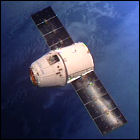 The third SpaceX Dragon unmanned resupply mission to the International Space Station lifts off, testing a new version of SpaceX’s Falcon 9 booster rocket which incorporates landing legs and an attitude control system designed to return the booster’s first stage safely to Earth for possible reuse. The attitude control system succeeds in cancelling out the booster’s roll and brings the first stage down for a controlled splashdown in the Atlantic Ocean. The Dragon capsule goes on to dock with the ISS two days later.
The third SpaceX Dragon unmanned resupply mission to the International Space Station lifts off, testing a new version of SpaceX’s Falcon 9 booster rocket which incorporates landing legs and an attitude control system designed to return the booster’s first stage safely to Earth for possible reuse. The attitude control system succeeds in cancelling out the booster’s roll and brings the first stage down for a controlled splashdown in the Atlantic Ocean. The Dragon capsule goes on to dock with the ISS two days later.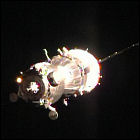 The 122nd Soyuz vehicle launched, Soyuz TMA-13M, lifts off from Russia to the International Space Station, carrying the station’s 40th crew to its stay in orbit. Aboard are flight engineers Maksim Surayev, Greg Wiseman and Alexander Gerst; of the three, only Surayev has previous spaceflight experience, and he will become the ISS Commander upon the departure of Expedition 39. Expedition 40’s stay aboard the ISS is slated to last six months, and Soyuz TMA-13M will be used as a return vehicle by the crew of Expedition 41 later in 2014. Though Soyuz TMA-13M was intended to use the recently developed six-hour fast-track launch trajectory to reach the station the same day it launched, technical glitches delayed its arrival at the ISS until May 28th.
The 122nd Soyuz vehicle launched, Soyuz TMA-13M, lifts off from Russia to the International Space Station, carrying the station’s 40th crew to its stay in orbit. Aboard are flight engineers Maksim Surayev, Greg Wiseman and Alexander Gerst; of the three, only Surayev has previous spaceflight experience, and he will become the ISS Commander upon the departure of Expedition 39. Expedition 40’s stay aboard the ISS is slated to last six months, and Soyuz TMA-13M will be used as a return vehicle by the crew of Expedition 41 later in 2014. Though Soyuz TMA-13M was intended to use the recently developed six-hour fast-track launch trajectory to reach the station the same day it launched, technical glitches delayed its arrival at the ISS until May 28th. SpaceX founder Elon Musk unveils the Dragon V2 manned spacecraft, an evolution of the unmanned Dragon capsules that have been ferrying cargo to the International Space Station. With room for seven astronauts and 3-D printed engines that can output 16,000 pounds of thrust, Dragon V2 is said to be fully reusable and should be capable of landing propulsively on land rather than splashing down in a body of water. While many of the vehicles impressive specifications are revealed, no announcements are made of when NASA might permit a manned test flight to the ISS, or how far along Dragon V2 is in meeting NASA’s exacting standards for manned spacecraft.
SpaceX founder Elon Musk unveils the Dragon V2 manned spacecraft, an evolution of the unmanned Dragon capsules that have been ferrying cargo to the International Space Station. With room for seven astronauts and 3-D printed engines that can output 16,000 pounds of thrust, Dragon V2 is said to be fully reusable and should be capable of landing propulsively on land rather than splashing down in a body of water. While many of the vehicles impressive specifications are revealed, no announcements are made of when NASA might permit a manned test flight to the ISS, or how far along Dragon V2 is in meeting NASA’s exacting standards for manned spacecraft. The University of Nebraska Press publishes
The University of Nebraska Press publishes 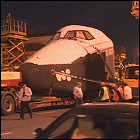 One of the last remaining prototypes of the Soviet-era Buran space shuttle is transported over land (and in pieces) from Gorky Park to an exhibition center in the center of Moscow to become part of an exhibit of Russian technological accomplishments. The unfinished Buran spaceframe had served numerous uses during its 30+ stay in Gorky Park, ranging from an impressive display piece to a diner (!).
One of the last remaining prototypes of the Soviet-era Buran space shuttle is transported over land (and in pieces) from Gorky Park to an exhibition center in the center of Moscow to become part of an exhibit of Russian technological accomplishments. The unfinished Buran spaceframe had served numerous uses during its 30+ stay in Gorky Park, ranging from an impressive display piece to a diner (!).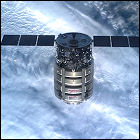 Orbital Sciences and NASA launch the second Cygnus unmanned cargo freighter to the International Space Station. Named after a recently deceased Shuttle astronaut, the S.S. Janice Voss carries over 3,000 pounds of new equipment and supplies to the station, where it remains docked for a month.
Orbital Sciences and NASA launch the second Cygnus unmanned cargo freighter to the International Space Station. Named after a recently deceased Shuttle astronaut, the S.S. Janice Voss carries over 3,000 pounds of new equipment and supplies to the station, where it remains docked for a month. Part of the 40th full-time crew of the International Space Station lifts off from Russia’s Baikonur Cosmodrome aboard Soyuz TMA-14M. Upon arriving in orbit, one of the Soyuz solar panel “wings” fails to deploy, only unfolding properly once the vehicle has docked at the ISS. Aleksandr Samokutyayev, Yelena Serova and Barry Wilmore take up residence on the ISS, becoming part of the Expedition 40 and 41 crews. This crew returns to Earth in March 2015 aboard the same vehicle.
Part of the 40th full-time crew of the International Space Station lifts off from Russia’s Baikonur Cosmodrome aboard Soyuz TMA-14M. Upon arriving in orbit, one of the Soyuz solar panel “wings” fails to deploy, only unfolding properly once the vehicle has docked at the ISS. Aleksandr Samokutyayev, Yelena Serova and Barry Wilmore take up residence on the ISS, becoming part of the Expedition 40 and 41 crews. This crew returns to Earth in March 2015 aboard the same vehicle.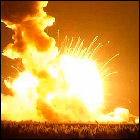 An unexpected malfunction destroys Orbital Sciences’ unmanned Cygnus cargo spacecraft a mere six seconds after its Antares booster rocket leaves the ground. Supplies and experiments bound for the
An unexpected malfunction destroys Orbital Sciences’ unmanned Cygnus cargo spacecraft a mere six seconds after its Antares booster rocket leaves the ground. Supplies and experiments bound for the  Virgin Galactica’s suborbital tourist spacecraft SpaceShip Two is launched on its first rocket-powered test since January 2014, this time using a modified rocket engine and a fuel mixture different from its previous test flights. Within seconds of its release and the firing of its engine, things go disastrously wrong: an explosion rips through the vehicle, which tumbles into the Mojave Desert from an altitude of 50,000 feet. One of SpaceShip Two’s pilots, Michael Alsbury, is killed on impact; the other pilot ejects from the vehicle and parachutes to the ground, though he is still severely injured. Virgin Galactic and the National Transportation Safety Board begin an investigation into the accident; though this first flightworthy SpaceShip Two model, the VSS Enterprise, is destroyed, another is under construction.
Virgin Galactica’s suborbital tourist spacecraft SpaceShip Two is launched on its first rocket-powered test since January 2014, this time using a modified rocket engine and a fuel mixture different from its previous test flights. Within seconds of its release and the firing of its engine, things go disastrously wrong: an explosion rips through the vehicle, which tumbles into the Mojave Desert from an altitude of 50,000 feet. One of SpaceShip Two’s pilots, Michael Alsbury, is killed on impact; the other pilot ejects from the vehicle and parachutes to the ground, though he is still severely injured. Virgin Galactic and the National Transportation Safety Board begin an investigation into the accident; though this first flightworthy SpaceShip Two model, the VSS Enterprise, is destroyed, another is under construction.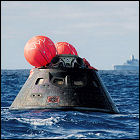 NASA launches Exploration Flight Test 1, the maiden unmanned voyage of the next-generation Orion space vehicle which is intended to assume the Space Shuttle’s place as NASA’s primary manned spacecraft. Heavily instrumented, Orion is boosted to a high altitude of 3,600 miles during its second orbit, and returns to Earth at 20,000mph, the fastest return of a man-rated spacecraft since the Apollo lunar missions. The flight profile of the EFT-1 mission is similar to that of 1967’s
NASA launches Exploration Flight Test 1, the maiden unmanned voyage of the next-generation Orion space vehicle which is intended to assume the Space Shuttle’s place as NASA’s primary manned spacecraft. Heavily instrumented, Orion is boosted to a high altitude of 3,600 miles during its second orbit, and returns to Earth at 20,000mph, the fastest return of a man-rated spacecraft since the Apollo lunar missions. The flight profile of the EFT-1 mission is similar to that of 1967’s